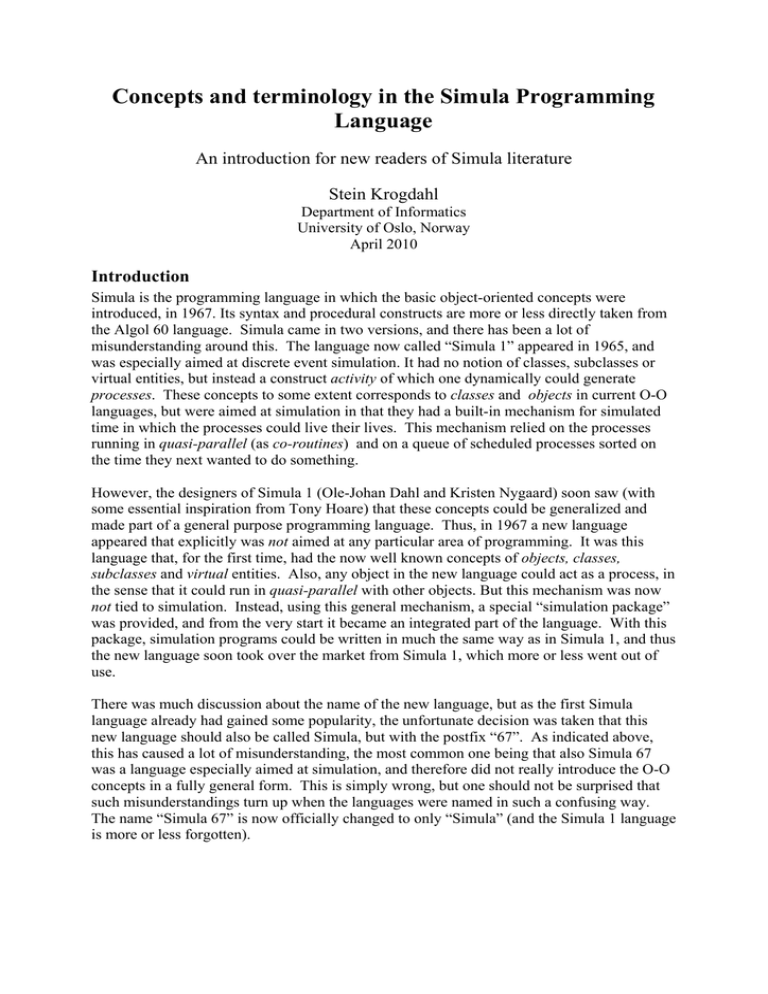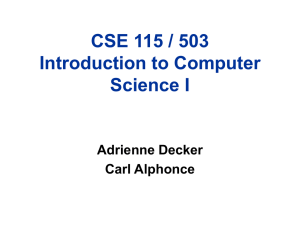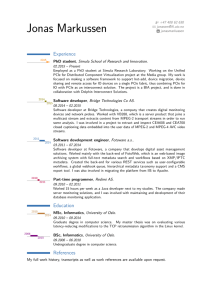Concepts and terminology in the Simula Programming Language
advertisement

Concepts and terminology in the Simula Programming
Language
An introduction for new readers of Simula literature
Stein Krogdahl
Department of Informatics
University of Oslo, Norway
April 2010
Introduction
Simula is the programming language in which the basic object-oriented concepts were
introduced, in 1967. Its syntax and procedural constructs are more or less directly taken from
the Algol 60 language. Simula came in two versions, and there has been a lot of
misunderstanding around this. The language now called “Simula 1” appeared in 1965, and
was especially aimed at discrete event simulation. It had no notion of classes, subclasses or
virtual entities, but instead a construct activity of which one dynamically could generate
processes. These concepts to some extent corresponds to classes and objects in current O-O
languages, but were aimed at simulation in that they had a built-in mechanism for simulated
time in which the processes could live their lives. This mechanism relied on the processes
running in quasi-parallel (as co-routines) and on a queue of scheduled processes sorted on
the time they next wanted to do something.
However, the designers of Simula 1 (Ole-Johan Dahl and Kristen Nygaard) soon saw (with
some essential inspiration from Tony Hoare) that these concepts could be generalized and
made part of a general purpose programming language. Thus, in 1967 a new language
appeared that explicitly was not aimed at any particular area of programming. It was this
language that, for the first time, had the now well known concepts of objects, classes,
subclasses and virtual entities. Also, any object in the new language could act as a process, in
the sense that it could run in quasi-parallel with other objects. But this mechanism was now
not tied to simulation. Instead, using this general mechanism, a special “simulation package”
was provided, and from the very start it became an integrated part of the language. With this
package, simulation programs could be written in much the same way as in Simula 1, and thus
the new language soon took over the market from Simula 1, which more or less went out of
use.
There was much discussion about the name of the new language, but as the first Simula
language already had gained some popularity, the unfortunate decision was taken that this
new language should also be called Simula, but with the postfix “67”. As indicated above,
this has caused a lot of misunderstanding, the most common one being that also Simula 67
was a language especially aimed at simulation, and therefore did not really introduce the O-O
concepts in a fully general form. This is simply wrong, but one should not be surprised that
such misunderstandings turn up when the languages were named in such a confusing way.
The name “Simula 67” is now officially changed to only “Simula” (and the Simula 1 language
is more or less forgotten).
Concepts and terminology
The terminology used for some important concepts in Simula is different from what later
become the norm in O-O programming. This has had the unfortunate effect that most articles,
books and papers about Simula have been difficult to read for those only knowing the
“standard” terminology used today. This is a pity, and below we explain the main concepts
and the terminology used in Simula to the extent that such articles should be straight forward
to read.
Class
Simula has classes in very much the same way as e.g. Java later adopted. Their
syntactic structure is as follows:
class C(…); ! Formal parameters within the parenthesis ;
begin
…
end;
Thus, Simula uses “begin … end;” in the same way as “{ … }” is used e.g. in Java.
More about parameters and other details around classes is given below. As is seen,
comments in Simula start with “!” and end at the first “;”.
Prefix classes and superclasses
The word prefix is used in Simula in a way that most closely corresponds to “super” in
e.g. Java, and it stems from the special syntax used in Simula where the name of the
superclass is given as a prefix to the class declaration. Thus, the following Simula
class declaration:
A class B; begin … end;
corresponds to the following Java declaration:
class B extends A { … }
Thus we e.g. have the following correspondences:
o Prefix class = super class = base class
o Multiple prefixing = multiple inheritance (but this is not offered in Simula)
Prefixed block
This is a special variation of the usage described above. In Simula, classes within
classes are allowed to any depth, and one is encouraged to use classes with local
classes to implement concepts that naturally comprise more than one class. Thus the
concept Graph (in fact, directed graph, as the edge has a from and a to end) can in
Simula be described e.g. as follows (where only some crucial variables are mentoned):
class Graph;
begin
class Node; begin
ref(Edge) firstEdgeOut; … ! The first in a list of outgoing edges ;
end;
class Edge; begin
ref(Node) from, to;
ref(Edge) nextEdgeOut; … ! The next in the list of outgoing edges;
end;
end;
2
When we want to use these classes we can prefix a block, usually the outermost, with
the name of the outer class Graph. This has the effect that that block acts as if it is the
body of a subclass of Graph, so that all the declarations inside class Graph become
directly available in the block.
Graph begin
Node class LargeNode; begin integer size; … end;
ref(LargeNode) rLN;
rLN :- new LargeNode; ! More about “reference assignments” below ;
rLN.size := 12345;
end;
Regrettably, it is not allowed to prefix a block with more than one class, which to
some extent reduces the usability of this mechanism, as one would often like to
“import” more than one such functional unit e.g. from a library. Note that one could
use the following construct:
Module1 begin
Module2 begin
… We can here refer to all declarations in Module1 and in Module2 …
end;
end;
However, because of block level restrictions for subclassing (see below), we cannot
make subclasses of the classes in Module1 inside the block prefixed with Module2,
and this reduces the value of such a construct.
Later languages has adopted constructs similar to block prefixing, e.g. Beta and Java
(as anonymous classes).
ref(C) a, b;
As shown above, Simula uses “ref(C)” to indicate that you use class C as a type.
Thus “ref(C) a, b;” corresponds to what is written “C a, b;” in Java. For the basic
value types (boolean, integer, real etc.), Simula uses the same syntax as Java (except
that Simula does not allow explicit initialization). The “no reference” value is in
Simula written: none.
Assignment
Simula uses “:=” for standard value assignment. However for reference assignments,
that is, for variables of type “ref(C)” for some class C, the operator “:-” is used. This
is almost totally redundant, but for texts (strings) one can use either operator and get
different effect. In Simula, texts are stored in special objects called text objects, and
one can have references to such objects in the same way as to ordinary class objects.
Thus, if we write “text t, u;”, we get two variables that can hold such references, and
we can perform the following assignments: “t:= u” and “t:-u”. The former will copy
the text of the (text) object pointed to by u into the object pointed to by t. The latter
will set t to reference the same text object as u does.
If a reference assignment in Simula is made the “wrong way” (to a variable typed with
a subclass of the type of the expression), Simula will automatically insert a run time
test.
3
Boolean operators
In Simula the following boolean operators:
For boolean values: and, or, not
For numeric and text values: =, <>, <=, >=, <, >
For references (also text references): ==, =/=
Simula uses the keyword “procedure”.
For the standard concept method/function/procedure Simula uses the word procedure
in all cases, even when a result is returned. Note that procedures can be declared
anywhere in a program, not only at the outermost level within classes. This includes
the outermost level of the program (global procedure), and inside another procedure.
Examples of procedure declarations:
procedure action(a, b); integer a; ref(C) b; begin … end;
boolean procedure isGood(a, b); ref(C) a, b; begin … isGood:= false; … end;
A type procedure (one that returns a result) will implicitly get a local variable typed
and named as the procedure itself. The returned value is the value of this variable at
procedure termination (that is, when execution passes through the “end” of the
procedure). Simula has no return statement.
Simula allows procedures to have procedure parameters (“formal procedures”). Also
a variant of “by variable” transmission is offered, which is called “by name”
transmission (an inheritance from the language Algol 60). None of these modes are
allowed for classes. If a procedure doesn’t have parameters, no parentheses are used.
Note that in Simula parameters of type ref(C) are said to be transmitted “by reference”
even when the simplest form of transmission is used, which is the same as Java’s
“value” transmission of references.
Parameters to classes
Classes may have parameters, and syntactically they occur after the name of the class,
exactly as for procedures. However, only parameters that are transmitted by value in
the Java sense are legal for classes (which includes transmission “by reference” in the
Simula sense). The formal parameters of a class are in every way considered normal
attributes of the class, e.g. in that they can be accessed by “dot-notation”. The only
difference is that they are initated to the values of the actual parameters. Subclasses
will inherit the parameters of the superclass, but may itself specify additional
parameters. Thus, in a “new C(…)” operation one has to give as many actual
parameters as given in C and in all its superclasses together, starting with those of the
outermost superclass.
Type-casting and “qua”
What in Java is written “((C)r).a” is in Simula written “r qua C.a” (where C can only
be a class). Note that no parentheses are needed.
Co-routines and quasi-parallel execution
As mentioned in the introduction, “the code of” an object can run in quasi-parallel
with the code of other objects. Below we give a slightly simplified explanation of
how this works.
4
A class is syntactically very similar to a procedure, also in that after the declarations of
the class, executable code may follow. That code is started immediately after a new
object is generated and the parameters are transmitted. This code can be used to
initialize the object, but it can also perform the very special statement “detach”, which
means that the execution control goes back to the “main program” (we give no
detailed explanation of this concept) where it last left. Also, the object itself
remembers where it (last) executed a detach. Later, one may, from the main program
or from another object, say “resume” (or “call”, which are technically slightly
different) to the object, and the object will then resume its actions from where it last
stopped. If the resume operation comes from another object, that object will now be
detached so that it can later resume execution from that point.
While an objects executes in quasiparallel with others, it may get its own call stack by
calling procedures, and a “detach” or a “resume” performed from within its own call
stack will then work so that the object itself is detched. However, the “resume point”
for this object is then set inside the procedure call at the top of the stack at the place
where it performed the “detach” or “resume” operation. Thus, if this object is later
resumed, it will start at this point, with the full stack preserved from last time it
executed. As every object in a quasiparallel execution in this way may have its own
stack, Simula is often characterized as a multi-stack language. Simula does not have
any mechanism for running objects in real parallel.
Visibility regulation: hidden and protected
At the outset in 1967, Simula had no mechanisms for regulating the visibility of
names. However, the need for this soon became clear, and around 1972 such a
mechanism was added. It works so that a declaration local to a class can be declared
protected, which means that it can only be accessed from inside an object of that class,
and of subclasses. When it is declared protected, it can also be declared hidden either
in the same class or in a subclass. This has the effect that it will not be visible in
further subclasses.
The virtual mechanism
In Simula, not only procedures can be virtual, but also labels and switches (a sort of
label arrays). However, this is now almost forgotten, and probably never used.
Procedures can be declared either virtual or not (as e.g. in C++ and C#), and if virtual
it can optionally be “abstract” in the sense that no implementation is given in that
class. In the 1967 definition parameters to virtual procedures had to be type checked at
run time (to obtain a certain freedom), but later syntax was added so that one may
have them checked during compilation, as in most modern typed O-O languages.
Subclasses and block levels
In Simula, subclasses can only be declared at the same “block level” as the superclass.
So, if the closest surrounding block of the subclass declaration is B (a procedure, a
class, or a prefixed or simple block), also the superclass must be declared in B. A
small exception is that if B is a class or prefixed block, then the superclass may be
declared in the prefix (superclass) of the class/block. The rules are so strict to avoid
any attempt to access variables declared in blocks that are terminated. Thus, you
cannot, e.g., in some procedure where you suddenly need it, declare your own subclass
of a class declared further out, and this is sometimes a pity. When you fetch a
5
separately compiled class e.g. from a library it is automatically given a block level so
that its fits into the program.
This strict block level rule is relaxed in many later languages, e.g. in Beta and in Java.
However, in Java this has resulted in some “strange” restrictions concerning variable
access from inner (nested) classes.
Simula has no “most general class”, like Java’s “Object”
There is nothing in Simula corresponding e.g. to the predefined class Object in Java.
However, all classes declared without a superclass implicitly get some predefined
procedures.
Simula’s inner
The executable code of a class can, by the keyword “inner”, indicate that the
corresponding code of the actual subclass (if one exist) should be executed here.
Assume we have the following classes:
class A; begin <code A1>; inner; <code A2> end;
A class B; begin <code B1>; inner; <code B2> end;
B class C; begin <code C1>; inner; <code C2> end;
When an object of class C is generated, the execution order of the code is as follows:
<code A1>; <code B1>; <code C1>; <code C2>; <code B2>; <code A2>
Thus e.g. class A can control the start and termination of the execution of the code
provided by its subclasses. If no inner is given, one is assumed before the terminating
end of the class body. Some later languages also offer a similar construct (at least
Beta and gbeta).
Simula attributes and members
In Simula, everything declared at the outermost level within a class (or a superclass) is
said to be an attribute of that class or of an object of that class. The word member can
definitely not be used with a meaning similar to that of attribute, but instead any
object of a class or of a subclass is said to be a member of that class. Thus, a class
corresponds to a set whose members are the objects of that class (including its
subclasses), and thus the word sub-class get its proper meaning.
No exceptions, but goto and detach statements
Simula has nothing like the exception mechanism of e.g. Java (that can bring you
backwards along the call chain in a controlled way). However, Simula has an
expressive goto statement that can bring you to a statically visible label (written as a
name followed by a colon in front of a statement). The label may be declared in any
textually surrounding block, and the control will be transferred to that point, and all
blocks in between will be terminated in a controlled way. Another way to obtain an
exception-like effect is to use a detach statement from within a procedure that is called
(directly or indirectly) from an object. This will bring you dynamically backwards to
that object, this object will be detached (as explained above), and the control goes
back to the “main program”. Explicit information cannot be transmitted with any of
these mechanisms.
---ooo--6
7




